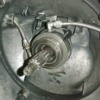From my experience working with owners, I think the Pantera hydraulic clutch system is one of the most misunderstood parts of the Pantera. When all the parts in the clutch system are functioning and adjusted correctly the system works excellent. On the other hand if the adjustments are off it can be a mess! And if the wrong clutch plate and cover are used it is a super mess.
The amount of movement that the slave can move is pretty well fixed by the piston area ratio between the master and slave. There are some adjustments at the master and pedal linkage, e.g. how high the pedal is set, free play between the push rod and master piston, that can impact movement but most of the adjustment problems are usually found at the slave end of the system.
The adjustable stop serves a number of functions:
1. Provides an adjustable free play stop at the closest point to the throw out bearing.
2. Prevents the slave piston form bottoming out in the slave bore and causing damage to the piston or bore.
3. Sets the starting point for the hydraulic fluid self adjusting movement starting point.
Because the total slave movement is fixed by the piston ratios the more free play you set with the adjustment stop the less of the fixed movement can be used to disengage the clutch. Here is a page on Pantera Place that might be helpful in understanding how to adjust the free play
http://www.panteraplace.com/page124.htmMike


